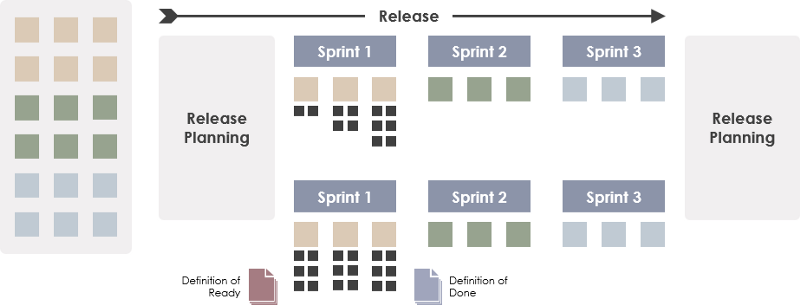Pengguna akhir terkadang memiliki ide atau konsep untuk fitur baru. Konsep tersebut direpresentasikan sebagai satu atau lebih item fungsi dan ditambahkan ke backlog produk oleh pemilik produk. Tim akan bekerja sama untuk mencari cara menerjemahkan konsep ini menjadi satu atau lebih epik, dan kemudian menyempurnakannya menjadi cerita pengguna yang lebih kecil dan jelas, yang akan dimasukkan ke dalam implementasi sprint berikutnya sebagai fungsi produk yang nyata.
Namun, memastikan bahwa cerita pengguna sudah siap sebelum sprint dapat memiliki dampak langsung dan signifikan terhadap produktivitas tim. Memiliki definisi “siap” berarti cerita tersebut harus segera siap untuk diimplementasikan. Tim harus dapat menentukan apa yang perlu dilakukan dan jumlah pekerjaan yang diperlukan untuk menyelesaikan cerita pengguna.
Tim akan mengambil cerita-cerita yang berada di puncak backlog produk ke dalam backlog sprint. Cerita-cerita ini harus dalam keadaan “siap”. Beberapa perusahaan sebenarnya membutuhkan daftar rinci untuk menentukan apakah sebuah cerita sudah “siap”, bukan hanya “hampir siap”.
Bagaimana Cara Membuat Definisi Siap?
Pemilik produk dapat bekerja sama dengan tim untuk mendefinisikan sebuah artefak yang disebut “definisi Siap” untuk memastikan bahwa item-item di puncak backlog siap dipindahkan ke dalam sprint sehingga tim pengembang dapat dengan yakin berkomitmen dan menyelesaikannya pada akhir sprint.

Mengapa Definisi Siap?
Definisi Siap adalah seperangkat kesepakatan yang memberi tahu semua orang kapan sesuatu siap untuk dimulai, misalnya ketika cerita pengguna sudah siap untuk dimasukkan ke dalam sprint, atau ketika semua kondisi yang diperlukan telah terpenuhi bagi tim untuk memulai sprint. Definisi siap yang sesuai akan secara substansial meningkatkan peluang tim Scrum dalam mencapai tujuan sprint mereka dengan sukses. Berikut adalah daftar manfaat yang dapat diberikan DoR yang terstruktur dengan baik kepada tim:
- Mengukur keadaan “siap” dari sebuah item backlog
- Memastikan bahwa item backlog produk telah dipikirkan “cukup matang”
- Membantu tim mengidentifikasi ketika pemilik produk atau anggota tim lain menjadi kewalahan
- Menjaga tim tetap saling bertanggung jawab satu sama lain
- Mengurangi tekanan pada tim untuk berkomitmen terhadap estimasi sebelum cerita dinyatakan “Siap”
- Mengurangi “perubahan kebutuhan” selama pengembangan
Contoh — Definisi Siap untuk Sprint
Tim yang berbeda akan memiliki Definisi Siap yang berbeda pula, dan beberapa memerlukan lebih sedikit. Misalnya, ada tim yang hanya mendeskripsikan nilai bagi pengguna, memprioritaskan, dan menuliskan cara untuk demo. Estimasi dan komunikasi lainnya dilakukan dalam rapat perencanaan sprint dan sebagainya. Berikut adalah contoh item yang perlu dipertimbangkan untuk mengembangkan DoR bagi tim Anda:
- Backlog Sprint diprioritaskan
- Backlog Sprint memuat semua cacat, Cerita Pengguna, dan pekerjaan lainnya yang menjadi komitmen tim
- Tidak ada pekerjaan tersembunyi
- Semua anggota tim telah menghitung kapasitas mereka untuk Sprint
- Penuh waktu pada proyek = X jam per hari
- Semua Cerita Pengguna memenuhi Definisi Siap
Contoh — Definisi Siap untuk Cerita Pengguna
Bagian ini menunjukkan contoh Definisi Siap untuk sebuah cerita pengguna, dan contoh Definisi Siap untuk Sprint. Anda dapat mengadopsi beberapa di antaranya sebagai titik awal atau dasar:
- Nilai Cerita bagi pengguna telah ditunjukkan dengan jelas.
- Kriteria penerimaan untuk Cerita telah dijelaskan dengan jelas.
- Ketergantungan Cerita Pengguna telah diidentifikasi
- Cerita Pengguna telah diperkirakan oleh Tim Pengiriman
- Tim Scrum menerima artefak Pengalaman Pengguna
- Kriteria kinerja telah diidentifikasi, bila perlu
- Orang yang akan menerima Cerita Pengguna telah diidentifikasi
- Tim mengetahui bagaimana mendemonstrasikan cerita tersebut.
Ringkasan
Istilah “definisi siap” tidak dijelaskan dalam panduan scrum. Istilah tersebut sama dengan cerita pengguna dan kriteria penerimaan yang menyertainya. Mungkin Anda berpikir bahwa definisi siap adalah bagian integral dari aktivitas penyempurnaan backlog produk, bukan menggunakan definisi siap sebagai checklist tahapan dan gerbang sekuensial. Penyempurnaan backlog adalah proses yang berlangsung terus-menerus, sehingga tidak terbatas pada sebuah acara, tetapi dianggap sebagai sebuah aktivitas.
This post is also available in Deutsch, English, Español, فارسی, Français, 日本語, Polski, Portuguese, Ру́сский, Việt Nam, 简体中文 and 繁體中文.













